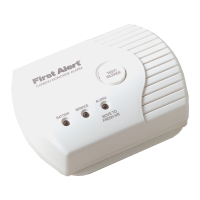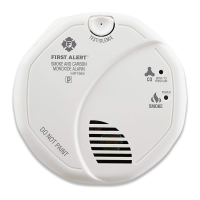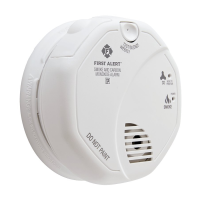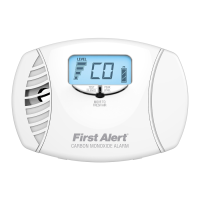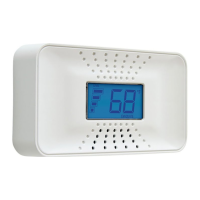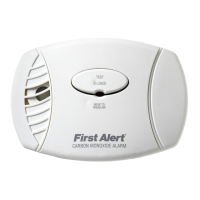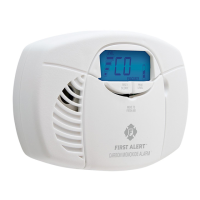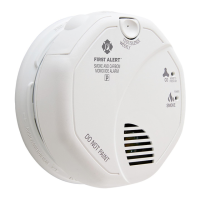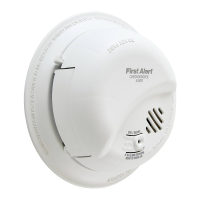Do you have a question about the First Alert FCD2DD and is the answer not in the manual?
Covers warnings about power failure, ignoring alarms, and reset feature misuse.
Instructions for removing a plastic tab to ensure proper detector operation.
Recommends consulting a doctor for individuals with health conditions or sensitive to CO.
Lists and illustrates common household items that can produce CO.
Explains how air pressure can cause CO to enter the home through flues.
Details how the detector samples air, stores readings, and enters alarm modes.
Identifies key parts of the detector and their functions.
Explains the information displayed on the digital screen, including CO levels and error messages.
Describes the meaning of different light indicators and alarm sounds.
Explains the temporary silencing function for alarms when no symptoms are present.
Details how the unit indicates a malfunction and what to do.
Lists dimensions, voltage, operating ranges, warranty, and safety standards.
Outlines specific CO concentrations and timeframes that trigger alarms according to UL standards.
Explains why early warnings are crucial for occupant safety and reaction time.
Provides general advice on placing detectors for optimal coverage and safety.
Specific guidance for placing detectors in single-story residences.
Guidance for placing detectors in homes with multiple floors.
Lists environments where the detector should not be placed due to performance interference.
Outlines warnings for use in multi-family dwellings and non-residential buildings.
Step-by-step guide for plugging in and testing the CO detector.
Routine care instructions, including testing and cleaning the unit.
Procedure for testing the detector's alarm function weekly.
Differentiates between the two alarm modes and their urgency.
Actions to take when the detector indicates an early warning of CO presence.
Immediate steps to take during a full CO alarm, including evacuation.
Factors that make locating CO sources difficult and how to approach it.
How to silence an early warning alarm temporarily.
How to silence a full alarm temporarily.
Defines CO, its properties, and common household sources.
Lists symptoms associated with mild, medium, and extreme CO exposure.
Provides advice on preventing CO problems and protecting household members.
Discusses the need for continuous power and sensor limitations.
Covers limitations related to alarm sound and detection range within a home.
Notes the limited operational life of the detector and the need for regular testing.
Explains why initial tests might not confirm CO presence.
Illustrates common sources of CO within a home, referencing numbered items.
Covers warnings about power failure, ignoring alarms, and reset feature misuse.
Instructions for removing a plastic tab to ensure proper detector operation.
Recommends consulting a doctor for individuals with health conditions or sensitive to CO.
Lists and illustrates common household items that can produce CO.
Explains how air pressure can cause CO to enter the home through flues.
Details how the detector samples air, stores readings, and enters alarm modes.
Identifies key parts of the detector and their functions.
Explains the information displayed on the digital screen, including CO levels and error messages.
Describes the meaning of different light indicators and alarm sounds.
Explains the temporary silencing function for alarms when no symptoms are present.
Details how the unit indicates a malfunction and what to do.
Lists dimensions, voltage, operating ranges, warranty, and safety standards.
Outlines specific CO concentrations and timeframes that trigger alarms according to UL standards.
Explains why early warnings are crucial for occupant safety and reaction time.
Provides general advice on placing detectors for optimal coverage and safety.
Specific guidance for placing detectors in single-story residences.
Guidance for placing detectors in homes with multiple floors.
Lists environments where the detector should not be placed due to performance interference.
Outlines warnings for use in multi-family dwellings and non-residential buildings.
Step-by-step guide for plugging in and testing the CO detector.
Routine care instructions, including testing and cleaning the unit.
Procedure for testing the detector's alarm function weekly.
Differentiates between the two alarm modes and their urgency.
Actions to take when the detector indicates an early warning of CO presence.
Immediate steps to take during a full CO alarm, including evacuation.
Factors that make locating CO sources difficult and how to approach it.
How to silence an early warning alarm temporarily.
How to silence a full alarm temporarily.
Defines CO, its properties, and common household sources.
Lists symptoms associated with mild, medium, and extreme CO exposure.
Provides advice on preventing CO problems and protecting household members.
Discusses the need for continuous power and sensor limitations.
Covers limitations related to alarm sound and detection range within a home.
Notes the limited operational life of the detector and the need for regular testing.
Explains why initial tests might not confirm CO presence.
Illustrates common sources of CO within a home, referencing numbered items.
| Brand | First Alert |
|---|---|
| Model | FCD2DD |
| Category | Carbon Monoxide Alarm |
| Language | English |



